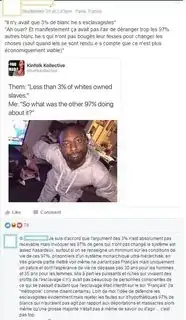I recently read a French post on Facebook saying that only 3% of white people owned slaves of African descent in the United States.
Here is a part of a debate in French quoting a twitter post about the initial claim.
Some more examples:
At the peak of black slavery in the South, only 6 percent of Southern whites owned slaves. If you include the white people in the North, it means that only 1.4 percent of white Americans owned black slaves at the HEIGHT of slavery.
One-quarter of all free families in the South (note, this category includes black free families) owned slaves, according to the 1860 U.S. Census. [...] In the Lower South (seceded before Fort Sumter), 36.7 percent of white families owned slaves. In the Upper South (seceded after Fort Sumter), the proportion was 25.3 percent. In the Confederate states as a whole, it was 30.8 percent. In the border states (which did not secede), the percentage of slave ownership was 15.9 percent. *
Another website with another numbers
(unless otherwise noted, all data is as of the 1860 census) Total number of slaves in the Lower South : 2,312,352 (47% of total population). Total number of slaves in the Upper South: 1,208758 (29% of total population). Total number of slaves in the Border States: 432,586 (13% of total population).
* Links provided by tim
What percentage of white people owned black slaves in the US?
